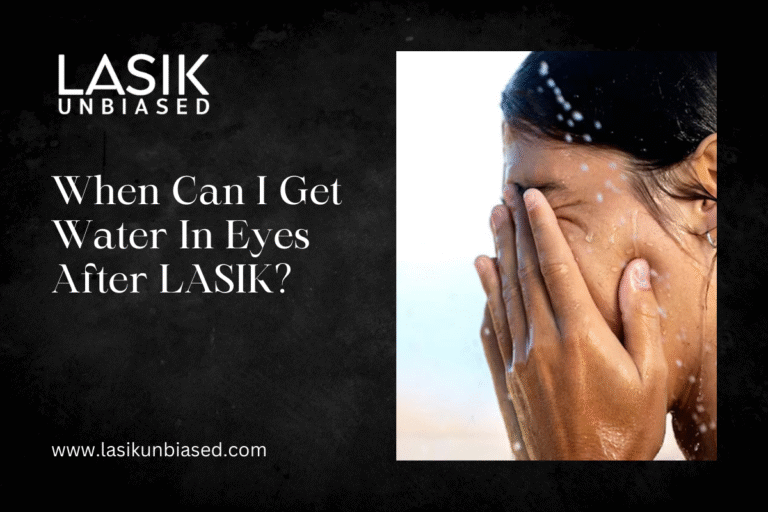You should avoid getting water in your eyes for the first week after LASIK surgery. This precaution helps reduce the risk of infection and protects the healing process.
LASIK is a life-changing procedure for many, offering the opportunity to live glasses-free. However, the success of your vision correction is also contingent upon your adherence to post-operative care instructions. Water in the eyes too soon after surgery can disrupt the delicate healing process and increase the risk of complications. This guide provides all the information you need to protect your eyes after LASIK, including when it’s safe to allow water near your eyes and how to navigate various situations involving water exposure to ensure the best possible outcome.
Why Water Exposure Matters After LASIK?
Water can introduce bacteria, irritants, and potential complications to your healing eyes if not managed carefully. Post-surgery, the cornea is more sensitive as it undergoes healing. Water might seem harmless, but it can disrupt this crucial recovery stage.
Tap water, pools, and even showers can carry bacteria that may cause infections. Additionally, the splashing pressure of water could irritate the cornea and dislodge the protective flap created during surgery. To avoid these risks and ensure a smooth recovery, it’s important to take precautions with water exposure.
How Soon Can You Shower After LASIK?
You can shower as soon as 24 hours after your LASIK procedure. However, it’s critical to keep soap, shampoo, and water from entering your eyes during this time. When showering, follow these steps:
- Avoid direct water spray on your face. Turn away from the showerhead or use a handheld shower to control water flow.
- Skip washing your face directly under the shower. Instead, use a damp cloth to gently clean around your eyes.
- Keep your eyes closed while rinsing your hair to prevent water or soap from dripping into them.
Following these guidelines ensures your eyes remain safe from irritation or infection while keeping you comfortably clean.
Swimming, Hot Tubs, and Natural Bodies of Water
Water activities like swimming in pools, hot tubs, or natural bodies of water demand extra caution. They pose a higher risk of infection compared to regular tap water due to the presence of chemicals, bacteria, and microorganisms.
How Long Should You Wait Before Swimming?
Avoid all swimming activities for at least two to three weeks after LASIK. Even with goggles, it’s best to wait until your eye doctor confirms it’s safe. Pool water contains chlorine, while lakes and oceans carry bacteria, both of which can irritate healing eyes or lead to infections.
For hot tubs, the waiting period may be longer. The warm water and jets create an environment where bacteria can thrive, so hold off until your surgeon gives the green light.
What About Natural Tears and Lubrication?
Your tears are essential for healing and maintaining comfort in your eyes. Often, LASIK patients experience temporary dry eye symptoms during recovery. To combat this, surgeons recommend using preservative-free artificial tears.
Avoid rinsing your eyes with water to relieve them if they feel dry. Instead, stick to the lubricating drops your provider has prescribed. These drops are sterile and specifically designed to protect your eyes during this delicate period.
Handling Face Washing and Skin Care Post-LASIK
Your daily skin care routine needs slight adjustments following LASIK. Being mindful of how you cleanse your face can help prevent water or products from irritating your eyes.
- Use gentle cleansers that do not foam excessively.
- Apply products like moisturisers and serums carefully, taking care not to go near your eyes.
- If needed, use a soft cotton pad or cloth around your eyes rather than splashing water.
Tips for Safe Eye Care After LASIK
Protecting your eyes during recovery is the priority. Here are essential tips to follow:
- Wear protective eyewear: Your surgeon may provide goggles or a sleep shield to avoid unintentional rubbing or accidental water exposure.
- Resist touching your eyes: Even wiping them with clean hands can disrupt the healing process.
- Limit outdoor exposure: Wind and dust can irritate healing eyes, so wear sunglasses when outside.
- Follow doctor-prescribed eye drops: Use only lubricating and medicated drops recommended by your care team, and avoid over-the-counter solutions unless approved.
Signs of Healing and When to Consult Your Doctor
It’s normal to experience mild blurriness and sensitivity during the initial recovery period, but significant discomfort or prolonged irritation isn’t typical. Keep an eye out for:
- Persistent redness or swelling
- Severe eye pain
- Unusual discharge or excessive tearing
- Worsening vision
If any of these symptoms arise, consult your surgeon immediately. Timely treatment can prevent complications and keep your healing on track.
Gradual Return to Normal Habits
By the end of the first week, it’s safe to resume light activities involving minimal water exposure, such as briefly rinsing your face with care. After about a month, most patients can safely return to swimming and other water-based activities, as long as they’ve received clearance from their doctor.
Patience and protective habits are the keys to a successful LASIK recovery. Taking small steps ensures your results are long-lasting and trouble-free.
Final Thoughts for a Smooth LASIK Recovery
LASIK can transform your vision and significantly enhance your quality of life, but its success depends on how well you care for your eyes throughout the healing process. Avoiding water exposure in the first week is crucial to protecting your corneas and preventing irritation or infections.
If you have additional questions about post-LASIK care or want to ensure you’re following the best practices for a smooth recovery, consult your surgeon. Your eyes are precious, and giving them the time to heal properly will set you up for years of clear and vibrant vision.


